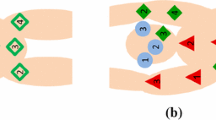Abstract
Purpose
Matching points that are derived from features or landmarks in image data is a key step in some medical imaging applications. Since most robust point matching algorithms claim to be able to deal with outliers, users may place high confidence in the matching result and use it without further examination. However, for tasks such as feature-based registration in image-guided neurosurgery, even a few mismatches, in the form of invalid displacement vectors, could cause serious consequences. As a result, having an effective tool by which operators can manually screen all matches for outliers could substantially benefit the outcome of those applications.
Methods
We introduce a novel variogram-based outlier screening method for vectors. The variogram is a powerful geostatistical tool for characterizing the spatial dependence of stochastic processes. Since the spatial correlation of invalid displacement vectors, which are considered as vector outliers, tends to behave differently than normal displacement vectors, they can be efficiently identified on the variogram.
Results
We validate the proposed method on 9 sets of clinically acquired ultrasound data. In the experiment, potential outliers are flagged on the variogram by one operator and further evaluated by 8 experienced medical imaging researchers. The matching quality of those potential outliers is approximately 1.5 lower, on a scale from 1 (bad) to 5 (good), than valid displacement vectors.
Conclusion
The variogram is a simple yet informative tool. While being used extensively in geostatistical analysis, it has not received enough attention in the medical imaging field. We believe there is a good deal of potential for clinically applying the proposed outlier screening method. By way of this paper, we also expect researchers to find variogram useful in other medical applications that involve motion vectors analyses.










Similar content being viewed by others
References
Chui H, Rangarajan A (2003) A new point matching algorithm for non-rigid registration. Comput Vis Image Underst 89(2):114141
Fitzgibbon AW (2003) Robust registration of 2D and 3D point sets. Image Vis Comput 21(13):11451153
Fischler MA, Bolles RC (1981) Random sample consensus: a paradigm for model fitting with application to image analysis and automated cartography. Commun ACM 24(6):381–395
Myronenko A, Song X (2009) Point set registration: coherent point drift. IEEE TPAMI 32(2):2262–2275
Jian B, Vemuri BC (2011) Robust point set registration using gaussian mixture models. IEEE Trans Pattern Anal Mach Intell 33(8):16331645
Stummer W, Pichlmeier U, Meinel T, Wiestler OD, Zanella F, Reulen HJ (2006) Fluorescence-guided surgery with 5- aminolevulinic acid for resection of malignant glioma: a randomised controlled multicentre phase III trial. Lancet Oncol 7(5):392–401
Paleologos TS, Wadley JP, Kitchen ND, Thomas DGT, Chandler WF (2000) Clinical utility and cost-effectiveness of interactive image-guided craniotomy: clinical comparison between conventional and image-guided meningioma surgery. Neurosurgery 47(1):4048
Schulz C, Waldeck S, Mauer UM (2012) Intraoperative image guidance in neurosurgery: development, current indications, and future trends. Radiol Res Pract 2012:19
Bayer S, Maier A, Ostermeier M, Fahrig R (2017) Intraoperative imaging modalities and compensation for brain shift in tumor resection surgery. Int J Biomed Image 2017, Article ID: 6028645
Gerard IJ, Kersten-Oertel M, Petrecca K, Sirhan D, Hall JA (2017) Brain shift in neuronavigation of brain tumors: a review. Med Image Anal 35:403–420
Hata N, Nabavi A, Warfield S, Wells W, Kikinis R, Jolesz FA (1999) A volumetric optical flow method for measurement of brain deformation from intraoperative magnetic resonance images, MICCAI, LNCS Vol.1679, 928935, Taylor C and Colchester A, Eds
Riva M, Hennersperger C, Milletari F, Katouzian A, Pessina F, Gutierrez-Becker B, Castellano A, Navab N, Bello L (2017) 3D intra-operative ultrasound and MR image guidance: pursuing an ultrasound-based management of brainshift to enhance neuronavigation. Int J CARS. https://doi.org/10.1007/s11548-017-1578-5
Reinertsen I, Lindseth F, Unsgaard G, Collins DL (2007) Clinical validation of vessel-based registration for correction of brain-shift. Med Image Anal 11(6):673684
Letteboer MM, Willems PW, Viergever MA, Niessen WJ (2003) Non-rigid registration of 3D ultrasound images of brain tumours acquired during neurosurgery, MICCAI 2003, LNCS vol.2879, 408415, Ellis RE and Peters TM, Eds
Toews M, Wells W (2013) Efficient and robust model-to-image alignment using 3D scale-invariant features. Med Image Anal 17:271–282
Cressie NAC (1991) Statistics for spatial data, p900. Wiley, USA
Calder CA, Cressie N (2009) Kriging and variogram models. Int Encycol Human Geo 2009:49–55
Matheron G (1963) Principles of geostatistics. Econ Geol 58:12461266
Kikinis R, Pieper SD, Vosburgh K (2014) 3D Slicer: a platform for subject- 24 specific image analysis, visualization, and clinical support. Intraoperative Imaging Image-Guided Therapy, Jolesz FA, Editor 3(19):277289
Haslett J, Brandley R, Craig P, Unwin A, Wills G (1991) Dynamic graphics for exploring spatial data with applications to locating global and local anomalies. Am Stat 45:234–242
Tukey JW (1977) Exploratory data analysis. Addison-Wesely, p 444
Acknowledgements
This work was supported by National Institute of Health Grants P41-EB015898-09 and P41-EB015902. This work was also supported by the International Research Center for Neurointelligence (WPI-IRCN) at the University of Tokyo Institute for Advanced Study.
Author information
Authors and Affiliations
Corresponding author
Ethics declarations
Conflict of interest
The authors declare that they have no conflict of interest.
Ethical approval
All procedures performed in studies involving human participants were in accordance with the ethical standards of the institutional and/or national research committee and with the 1964 Declaration of Helsinki and its later amendments or comparable ethical standards.
Informed consent
Informed consent was obtained from all individual participants included in the study.
Rights and permissions
About this article
Cite this article
Luo, J., Frisken, S., Machado, I. et al. Using the variogram for vector outlier screening: application to feature-based image registration. Int J CARS 13, 1871–1880 (2018). https://doi.org/10.1007/s11548-018-1840-5
Received:
Accepted:
Published:
Issue Date:
DOI: https://doi.org/10.1007/s11548-018-1840-5




